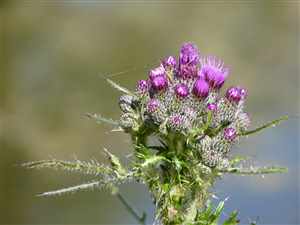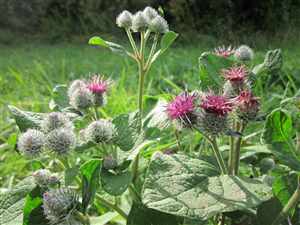Burdock (Arctium lappa)
Main Facts about Burdock

Burdock is a biennial plant that can grow up to 6 to 8 feet (2.4 m) tall. It has large rhubarb-like leaves and purplish flowers that precede the small burrs that harden as they ripen. Although native to Asia and Europe, this plant is now widespread throughout the United States, and is common in disturbed sites, such as ditches and roadsides. Parts used – root, seed heads, leaves, young stalks.
The plant’s common name comes from “bur”, for its burrs, and “dock”, an Old English word for plant. These burrs are said to have inspired the Swiss inventor George de Mestral to develop Velcro.
Since medieval times Burdock has been valued medicinally for its cleansing and antiseptic properties. Apparently King Henry VIII was cured of syphilis with Burdock and it was also used for leprosy. It was recommended for bites of snakes and mad dogs.
In traditional Chinese medicine, Burdock has long been used in combination with other herbs to treat skin redness, ulcers, sore throats, tonsillitis, colds, and measles. It is also used as a diuretic and blood purifier and is included in formulas designed to detoxify the liver and improve digestion. It’s also taken internally to treat inflammation. Native Americans used an infusion of the roots or seeds to cleanse blood and applied a poultice of the boiled leaves to sores.
Using Burdock
Burdock roots and seeds contain bitter glycosides, flavonoids, and tannins. Fresh Burdock roots contain phytochemicals called polyacetylenes, which can destroy certain bacteria and fungi, perhaps explaining the traditional use of this herb as a treatment for ringworm, urinary tract infections, and other bacterial outbreaks.
Consistent use of the tea (made from the root or seeds) may ease arthritis, gout, and sciatica by reducing the swelling around joints.
Burdock is a mild antibacterial agent, making it useful in the treatment of skin conditions, including acne and boils, and as an ingredient in some shampoos, creams, and lotions. Burdock’s root seems to work by preventing the body’s own immune system from attacking the skin. Burdock root oil extract (Bur oil) has traditionally been popular in Europe as a scalp treatment applied to improve hair strength, shine, and body, and to combat hair loss. It has been used to ease dandruff and scalp itching. It may be most effective for psoriasis if used over a long period of time. Similarly, all types of eczema (though primarily the dry kinds) may be treated effectively, if Burdock is used over a period of time.

Cancer researchers have discovered a substance in Burdock root capable of reducing cell mutation. Laboratory studies with animals suggest that the dietary fiber arctiin, found in Burdock seed, may slow or stop the growth of breast cancer in the early stages. This fiber may have similar benefits against leukemia, and colon and pancreatic cancers.
Externally it may be used as a compress or poultice to speed up the healing of wounds and ulcers. For seborrhea, massage Burdock root oil into your scalp. For internal usage boil 1 tsp. of the root in a cup of water, simmer for 10-15 min. Drink 3 times a day.
Burdock is a remedy for: Arthritis
Cooking with Burdock
Burdock is not an important edible plant, although the cultivated Japanese form, Gobo, is used as a vegetable and also in various pickles and a miso-based condiment. The roots are slivered, soaked in water to remove their bitter flavor, and stir-fried with sesame oil and soy sauce. It is also eaten as a vegetable in Korea. Scrape the young leaf stalks and cook them as you would Celery.
Look for Burdock-seed cereals, available as Gobo or Goboshi, in Japanese groceries. Burdock is also available as a tea.
To prepare Burdock root, peel, shop, then soak the root for about 30 min in several changes of cold water. Try combining the prepared root with shredded carrot, minced fresh ginger and lemon juice for an appetizer or salad. Young stalks can be peeled, chopped and steamed, like asparagus.
How to grow Burdock
Burdock grows easily from seeds planted in spring. Thin seedlings to 6-inch spacing. Burdock requires a moist, rich, deeply cultivated soil and full sun, although it will tolerate some light shade and poorer soils. It is also fully cold-hardy, and dies down in winter. Some gardeners mix wood chips or sawdust into Burdock beds to keep the soil loose so the 3-foot-long roots are easier to harvest in fall or the following spring.
Keep the soil moist and weed the crop regularly, particularly when the plants are young. Remove the flowers and burrs to promote root growth.
For cooking, collect young shoots and leaves in spring. Lift the roots in fall, about 100 days after planting, when they are at least 1 foot (30 cm) long. For medicinal purposes, dry the grayish brown roots, which are white on the inside.
| Buckthorn |
Butcher's Broom
|